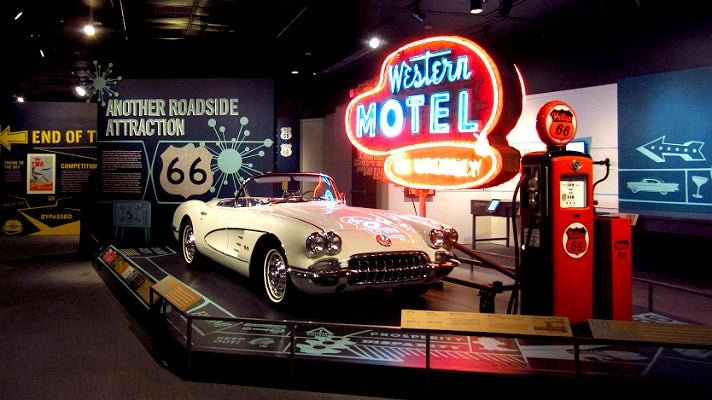Known as as the “Main Street of America” and the “Mother Road,” Route 66 was established on November 11, 1926 and became one of the most famous roads in America. The famed highway originally ran from Chicago to Santa Monica, covering a total of 2,448 miles. As a witness to history and a symbol for America on the move, Route 66 became a part of popular culture - it was immortalized in The Grapes of Wrath novel and film, the hit song (Get Your Kicks on) Route 66, and the Route 66 TV series in the 1960s.
Now on view at the Autry National Center through Jan. 4, 2015, Route 66: The Road and the Romance is an exhibition of more than 250 extraordinary artifacts that trace the history of the Mother Road and its impact on American popular culture. Route 66 travels the iconic road from its inception, through the Great Depression, to its heyday as a travel destination, and its decline and eventual displacement by the Interstate Highway System. The exhibition concludes with a contemporary look at the road and the movement for its preservation.
Route 66: The Road and the Romance presents historical artifacts from institutions and private collections across the United States, many displayed together for the first time. Read on for highlights of this remarkable exhibit, including special programs taking place at the Autry during the exhibit's run.
The Roots of the Route

The exhibition begins with The Roots of the Route, an overview of the major industrial and technological changes that radically altered American life and paved the way for a national network of roads. As the automobile replaced railroads as the chief mode of transportation, a new American landscape emerged, dotted with oil rigs and gas stations, motels and billboards. Thomas Hart Benton captured the era in his 1928 painting, Boomtown. The section concludes with the establishment of Route 66 in 1926, featuring many of the signs and promotional materials that helped make it the "Main Street of America.” Artifacts in this section include an early Jackson Pollock landscape painting, a ten-foot Texaco twin visible gas pump (ca. 1927), and a Model T four-cylinder engine (1924).
"The Grapes of Wrath"

Next, The Mother Road features artifacts and newsreel footage that document the extreme hardships of the Great Depression and Dust Bowl era, when weary refugees traveled Route 66 in search of a better life. The Mother Road features a variety of paintings and photographs that reflect their plight, including iconic photographs by Dorothea Lange, Arthur Rothstein, and Horace Bristol.
In his Pulitzer Prize-winning novel, The Grapes of Wrath, John Steinbeck tells the story of the Joads, who are driven from their Oklahoma home and set out for California. Artifacts include a page from Steinbeck's original handwritten manuscript for The Grapes of Wrath - the first time Route 66 was called "the mother road" - and John Ford’s Oscar for Best Director, The Grapes of Wrath (1940).
WOODY GUTHRIE

Among the countless travelers on Route 66 was legendary folk singer, Woody Guthrie, who hitchhiked along the highway from Texas to California in 1936. The songs he wrote about the Dust Bowl were based in large part on his experiences along Route 66. Many of these songs were released in 1940 on the acclaimed Dust Bowl Ballads, the most successful and influential album of Guthrie's career. On view are Woody Guthrie's 1937 Martin guitar, along with hand-drawn lyrics and sketches, and various personal effects. Visitors may also listen to selections from Dust Bowl Ballads.
Another Roadside Attraction

Another Roadside Attraction explores Route 66 in its golden age, as increased tourism and a burgeoning car culture turned the highway into a major thoroughfare and vacation destination. The postwar boom and growing consumerism are illustrated through promotional materials the average traveler would have seen on the road, including a complete set of Burma Shave signs, a Phillips 66 gasoline pump, and a large “Western Motel” neon sign (ca. 1950). Some objects in this section look beyond the romance of the road, from stereotypical Native American promotional souvenirs, to African American segregation and news reports on the treacherous accidents that inspired the “Bloody 66” moniker.
“(Get Your Kicks On) Route 66”

Route 66 was immortalized in the song (Get Your Kicks On) Route 66, written by Bobby Troup and recorded by Nat “King” Cole in 1946. Troup was inspired to write the song while driving on Route 66 from Pennsylvania to Los Angeles - the map used by Troup is on display. The catchy song became a hit and turned Route 66 into a national phenomenon and even inspired a TV series. (Get Your Kicks On) Route 66 has become a pop standard, covered by everyone from Perry Como to The Rolling Stones and Depeche Mode. A jukebox lets visitors browse and listen to 120 versions of the song.
“On the Road” Scroll

The emerging youth generation, including the rebellious Beats, also made use of the new highways. Jack Kerouac’s 1957 novel, On the Road, embodies their thirst for freedom. Kerouac’s On the Road manuscript, a 120-foot-long, single-spaced typed scroll, is on display in Los Angeles for the first time. Route 66 marks the longest period of time the scroll will be on display in an exhibit. Accompanying the scroll is a digital scan that offers visitors complete, close-up access to its contents.
"Cars"

The final section - appropriately named End of the Trail - documents the decline of Route 66, beginning in 1956 when it was bypassed by the Interstate Highway System. The rise of air travel, the allure of attractions such as Disneyland and Las Vegas, and commercial exploitation were all factors in its degradation.
The decline of Route 66 is portrayed in the Pixar Animation Studios film, Cars (2006), which introduced the highway to a new generation. One area of End of the Trail showcases the creative process behind the movie, from early research photos to sketches, models, and storyboards. The popular character, Mater, was inspired by an actual 1951 International Harvester boom truck that the Pixar team discovered while driving on Route 66.
"End of the Trail"

The exhibition finishes with examples of the work of the National Park Service and preservationists to restore and revive the Mother Road’s rich history and heritage, an ongoing process initiated in 1999 with the enactment of the Route 66 Corridor Preservation Program. Visitors can also share their experiences and thoughts about the highway by filling out postcards and placing them on a special map of Route 66.
MORNING JOE AND THE MOTHER ROAD

The Autry is presenting a variety of related programs throughout the run of the Route 66 exhibition. Morning Joe and the Mother Road takes place from 9-11 a.m. on select weekend mornings. Local classic car clubs will gather in the Autry parking lot for an opportunity to meet like-minded car enthusiasts. Open to the general public, Morning Joe and the Mother Road offers a chance to see classic automobiles that could have traveled the Mother Road, enjoy a complimentary cup of coffee, and then see the exhibition in a whole new light. Highlights include Thunderbirds of Southern California (June 21) and the Corvette Club (July 13). Admission to Morning Joe and the Mother Road events is free, and does not include entry to the Autry.
"What Is a Western?"
What Is a Western? is an ongoing film series at the Autry that examines a variety of movies about the American West. As part of the What Is a Western? series, the Autry presents three films that highlight the impact and significance of Route 66: The Grapes of Wrath (July 12), Bound for Glory (Aug. 9), and Cars (Sept. 14). Prior to each screening, Route 66 curator Jeffrey Richardson leads a discussion of the film’s history and its place within the Western genre. The movies screen at 1:30 p.m. in the Wells Fargo Theatre. Admission is included with museum entry.




